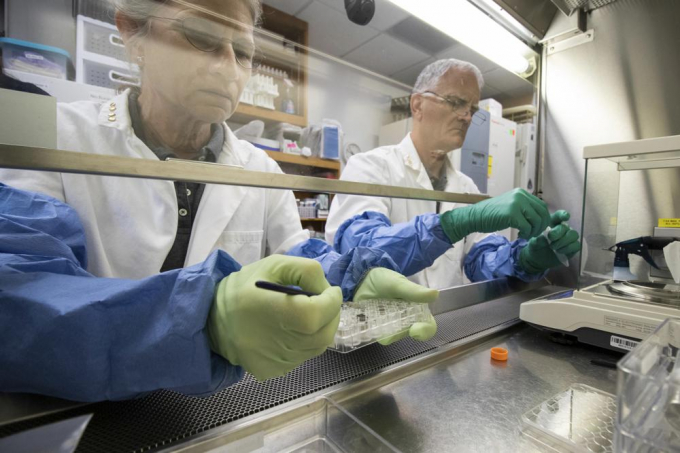November 27, 2025 | 17:18 GMT +7
November 27, 2025 | 17:18 GMT +7
Hotline: 0913.378.918
November 27, 2025 | 17:18 GMT +7
Hotline: 0913.378.918

In this 2021 photo provided by the University of Florida, Institute of Food and Agricultural Sciences, a researcher harvests a thale cress plant growing in lunar soil, at a laboratory in Gainesville, Fla. For the first time, scientists have used lunar soil collected by long-ago moonwalkers to grow plants, with results promising enough that NASA and others already are envisioning hothouses on the moon for the next generation of lunar explorers. Photo: Tyler Jones/UF/IFAS via AP
Researchers had no idea if anything would sprout in the harsh moon dirt and wanted to see if it could be used to grow food by the next generation of lunar explorers. The results stunned them.
“Holy cow. Plants actually grow in lunar stuff. Are you kidding me?” said Robert Ferl of the University of Florida’s Institute of Food and Agricultural Sciences.
Ferl and his colleagues planted thale cress in moon soil returned by Apollo 11′s Neil Armstrong and Buzz Aldrin, and other moonwalkers. The good news: All of the seeds sprouted.
The downside was that after the first week, the coarseness and other properties of the lunar soil stressed the small, flowering weeds so much that they grew more slowly than seedlings planted in fake moon dirt from Earth. Most of the moon plants ended up stunted.
Results were published Thursday in Communications Biology.
The longer the soil was exposed to punishing cosmic radiation and solar wind on the moon, the worse the plants seemed to do. The Apollo 11 samples — exposed a couple billion years longer to the elements because of the Sea of Tranquility’s older surface — were the least conducive for growth, according to scientists.
“This is a big step forward to know that you can grow plants,” said Simon Gilroy, a space plant biologist at the University of Wisconsin-Madison, who had no role in the study. “The real next step is to go and do it on the surface of the moon.”

In this 2021 photo provided by the University of Florida, Institute of Food and Agricultural Sciences, Anna-Lisa Paul, left, and Rob Ferl, work with lunar soils in their laboratory in Gainesville, Fla. For the first time, scientists have used lunar soil collected by long-ago moonwalkers to grow plants, with results promising enough that NASA and others already are envisioning hothouses on the moon for the next generation of lunar explorers. Photo: Tyler Jones/UF/IFAS via AP
Moon dirt is full of tiny, glass fragments from micrometeorite impacts that got everywhere in the Apollo lunar landers and wore down the moonwalkers’ spacesuits.
One solution might be to use younger geologic spots on the moon, like lava flows, for digging up planting soil. The environment also could be tweaked, altering the nutrient mixture or adjusting the artificial lighting,
Only 842 pounds (382 kilograms) of moon rocks and soil were brought back by six Apollo crews. Some of the earliest moon dust was sprinkled on plants under quarantine with the Apollo astronauts in Houston after returning from the moon.
Most of the lunar stash remained locked away, forcing researchers to experiment with simulated soil made of volcanic ash on Earth. NASA finally doled out 12 grams to the University of Florida researchers early last year, and the long-awaited planting took place last May in a lab.
NASA said the timing for such an experiment was finally right, with the space agency looking to put astronauts back on the moon in a few years.
The ideal situation would be for future astronauts to tap into the endless supply of available local dirt for indoor planting versus setting up a hydroponic, or all-water, system, scientists said.
“The fact that anything grew means that we have a really good starting point, and now the question is how do we optimize and improve,” said Sharmila Bhattacharya, NASA’s program scientist for space biology,
The Florida scientists hope to recycle their lunar soil later this year, planting more thale cress before possibly moving on to other vegetation.
(AP)

(VAN) A new study reveals how the simultaneous effects of ocean acidification, salinity and loss of oxygen are making the world more fragile.

(VAN) Hopes are growing that the creation of the first 3D turkey gut model could be a turning point in the battle against the virulent blackhead disease.

(VAN) Tyson, America’s biggest meat supplier, plans to shutter one of its largest beef processing plants as the industry continues to struggle with low cattle supplies and political pressure from Washington.

(VAN) New FAO study shows how digital solutions are empowering farmers and fishers to prevent losses and build resilient agrifood systems.

(VAN) Brazil's COP30 presidency pushed through a compromise climate deal on Saturday that would boost finance for poor nations coping with global warming but that omitted any mention of the fossil fuels driving it.

(VAN) Poultry farmers in the UK have been warned that they could face one of the worst winters yet for bird flu.

(VAN) Prices of main-crop paddy have risen sharply, with jasmine rice hitting 16,100 baht per tonne — the highest level in years.